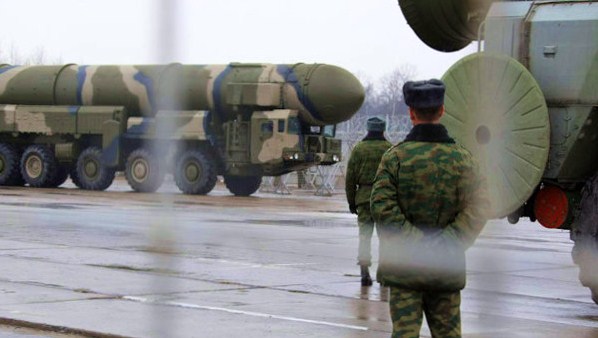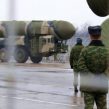
Putin Declares His Defense Agenda for the Next Decade
Publication: Eurasia Daily Monitor Volume: 9 Issue: 38
By:

Prime Minister Vladimir Putin, running for a third presidential term on March 4, has been publishing his election platform bit by bit as lengthy articles in different Moscow daily newspapers. This week it was the government-owned Rossiyskaya Gazeta that carried a 6,500-word text about defense industry development, military reform, foreign military threats and national security. The previous five covering the economy, social policy, ethnic problems, and demography, democracy and quality of government – were rambling and obscure, as election manifestos often are. The latest text – “Being Strong: National Security Guarantees for Russia” – is different, as it spells out Putin’s overwhelming fear of enemies that surround Russia from all directions, threatening invasions and sabotage and “exporting democracy.” To deflect these threats Russia, according to Putin, must re-establish and rearm itself in “ten years” as an awesome military superpower, second to none (Rossiyskaya Gazeta, February 20).
The plan seems ludicrous, taking into account Russia’s lopsided oil-export dependent economy and serious unresolved social, political and demographic problems, ethnic tension and destructive massive corruption. It could be an election ploy: militaristic bravado coupled with empty promises to restore old superpower glory to lure the masses to the ballot box to cast the correct vote. But Putin seems to be genuinely agitated and has repeated the main points of his article publicly at a meeting of defense industry chiefs in Komsomolsk-on-Amur in the Far East on February 20, and at a meeting with brigade and divisional commanders of the Armed Forces near Moscow on February 22 (https://premier.gov.ru/events/news/18194/, https://premier.gov.ru/events/news/18228/ ). Putin did not use prompters at ether meeting and seems to be in good command of the published text.
Putin insists, “Only nuclear weapons allowed Russia to maintain its independence in the troubled 1990s.” Developing and deploying an entirely new generation of nuclear weapons and delivery systems will be the main, but not the only priority of Putin’s massive rearmament program. By 2020, the defense industry must produce and deliver over 400 modern land and sea-based intercontinental ballistic missiles (ICBMs), eight strategic nuclear missile submarines and about 20 attack submarines. Over 50 surface warships, around 100 military spacecraft, over 600 modern aircraft including fifth generation fighter jets, more than 1,000 helicopters, 28 regiments of S-400 air defense missiles and 38 complexes of Vityaz missile air defense systems will also be required. Ten brigades will be equipped with Iskander-M ballistic missiles (500 km range, nuclear capable), over 2,300 modern tanks, some 2,000 pieces of self-propelled artillery and so on (Rossiyskaya Gazeta, February 20).
Speaking to military commanders, Putin boasted that Russia has already overtaken the mighty US in the presumed nuclear arms race by developing and deploying a new generation of nuclear weapons and ballistic missiles, “while the Americans have yet to modernize their nuclear arsenal.” Putin acknowledged, “Regretfully the US has surpassed us in producing and using powerful precision weapons, but we are working in that direction and our prospects are fine, maybe even better than theirs.” This is, according to Putin, the “asymmetrical” Russian response to the US challenge (https://premier.gov.ru/events/news/18228/).
Indeed, while the US has not developed new ICBMs since 1991, believing the Cold War and nuclear arms race are over, Russia is in the midst of an ambitious rearmament. The Commander of the Strategic Rocket Forces (RVSN) Lieutenant-General Sergey Karakayev, announced this week that at present 30 percent of Russian ICBMs are “new” (developed after 1991). By 2016, some 60 percent are planned to be “new” and by 2020 – 97 percent (RIA Novosti, February 21).
By 2020, some 20 trillion taxpayers rubles ($667 billion) are planned to be spent on weapons procurement and an additional 3 trillion ($100 billion) on modernizing and re-equipping the defense industry. Talking to defense industry chiefs in Komsomolsk-on-Amur, Putin stressed that 23 trillion ($767 billion) “is a lot,” and no further defense spending increases are possible: “We cannot simply spend them – we need results” (https://premier.gov.ru/events/news/18228/). To prevent massive misappropriation that may ruin the dream of Russian military superiority, Putin has threatened to equate military-related corruption to “high treason” and called for less secrecy in defense spending: “procurements must be open to public scrutiny” (Rossiyskaya Gazeta, February 20).
Putin’s defense manifesto contains other reasonable points. Putin concedes: “Russian defense institutions and industry have missed in the last 30 years several cycles of modernization.” In the next phrase, Putin goes daydreaming: “In the coming decade we must fully catch up and regain world leadership in all important military technologies.” Putin further added: “We must use all our strength to achieve technical, technological and organizational superiority over any potential adversary.” Among the fields of future development, Putin mentions mysterious “geophysical weapons” that, apparently, could allow at will to cause earthquakes and other seemingly “natural” disasters on far off continents. “Psychophysical weapons” that may control the behavior of entire nations are also mentioned. Putin believes such weapons, when developed, could be as deadly as nuclear weapons, while their use would be – “politically and militarily more acceptable” (Rossiyskaya Gazeta, February 20). This mix of valid points and fantasies continues throughout the text. Typically dictators become increasingly paranoid and megalomaniacal as their endless rule continues, slipping from the real world into outright lunacy. Putin in his 13th year of ruling Russia seems to be going down the same drain.
Putin declares “deeply untrue” the widespread opinion that developing the defense industry burdens the nation and that militarization bankrupted the USSR. Putin is sure that massive defense spending “will modernize the entire economy.” A revived military industry “as a locomotive” will pull the national economy into the future, creating new jobs and technologies, while at the same time turning Russia into a world leader and giving it the means to defend itself against malicious American encroachments that “create managed chaos” (in Putin’s words) in Russia and neighboring countries. Russia’s intent is to build the world’s finest weapons using primarily its revamped defense industry, but selected Western weapons and technologies are also welcome (Rossiyskaya Gazeta, February 20). Last week, the Chief of the Russian Navy, Admiral Vladimir Vysotskiy, announced that the amphibious Mistral assault ships ordered in France, will be equipped with Russian weapons, “possibly including special warheads” – the Russian military euphemism for nuclear weapons (RIA Novosti, February 16).
Outgoing president Dmitry Medvedev has made the “modernization” and “innovation” of Russia the theme of his withering one-term presidency. Now Putin has spelled out the true meaning of “modernization” and “innovation” Russian-style.




